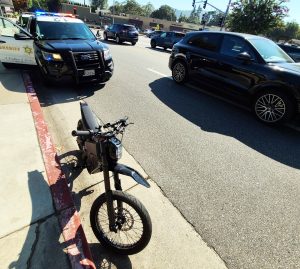
Photo courtesy of LASD
By Mary O’KEEFE
Although some may think the laws have not caught up with the popularity of e-bikes and e-scooters, there are laws that have been set up and should be followed accordingly.
- Micro-mobility devices, including e-bikes and e-scooters, are categorized into three levels: Class 1 and Class 2 have speeds that have a maximum of 20 mph, Class 3 e-bikes can reach up to 28 mph. E-scooters are motorized scooters powered by an electric motor and battery.
- Regulations in California are as follows:
- There is no license required to operate an e-bike or e-scooter.
- A helmet is required for riders under the age of 18 and riders of all Class 3 vehicles [maximum speed of 28 mph] must wear a helmet.
- E-bike riders must follow the same traffic laws as regular cyclists, including obeying all traffic signals and speed limits and observing the right-of-way.
- Federal limits for e-bikes is 20 mph under motor power alone; California allows Class 3 e-bikes to reach up to 28 mph when pedal-assisted. Riders must still follow local speed limits.
- No passengers are allowed on Class 3 e-bikes.
- E-bikes can be operated in designated bicycle lanes and on roadways where it is legal for a pedal bike but riders must be able to move with the flow of traffic.
Violations of these rules can include fines from $25 to over $100. If a city or municipality has ordinances restricting bikes and e-bikes ridden on sidewalks, penalties for violations can reach up to $500.
The history of e-bikes can be traced back to 1897 when Hosea Libbey patented a bike with two electric motors. The company Humber Limited in the U.S. also offered an e-bike in 1897. The trend of e-bikes continued but it wasn’t until recently, around 2020, that the battery technology became more advanced coupled with the need to reduce one’s carbon footprint.
The popularity of e-bikes and e-scooters grew with the creation of companies like Lime, which created a sort of fee-driven ride share possibility in cities. Using Limes, people take available e-bikes and e-scooters from the sidewalks, use their credit card to pay for a ride and take off. For a variety of reasons this has created some issues in many cities that have these programs including e-bikes/e-scooters just being dropped and left in the middle of a sidewalk or in front of a business by riders and also those under the age of 18 riding without a helmet.
There is a possible program that the City of Glendale is in the process of researching. CVW will cover this possibility in future articles.
E-bikes and e-scooters have also been growing in popularity for students. Glendale Unified School District (GUSD) has faced issues with this growing transportation trend.
GUSD’s administration is working with the Glendale Police Dept. on traffic safety presentations to start at high schools during the upcoming school year. The district has also reached out to Los Angeles County Sheriffs Dept. (LASD) and California Highway Patrol (CHP) for safety presentations. Crescenta Valley High School and Rosemont Middle School are within the unincorporated area of LA County and therefore under the jurisdiction of LASD and CHP, according to Hagop Eulmessekian, director of Student Support Services, GUSD.
“[E-bikes] are not allowed on campus,” Eulmessekian added. “All students are encouraged to use helmets and other protection.”
There are designated areas at school locations for students to security lock their e-bikes.
CVW will continue with to look at how rental programs in other cities work, the trends law enforcement is seeing and just because there are laws to regulate e-bikes and e-scooters, it doesn’t mean they are being followed.
